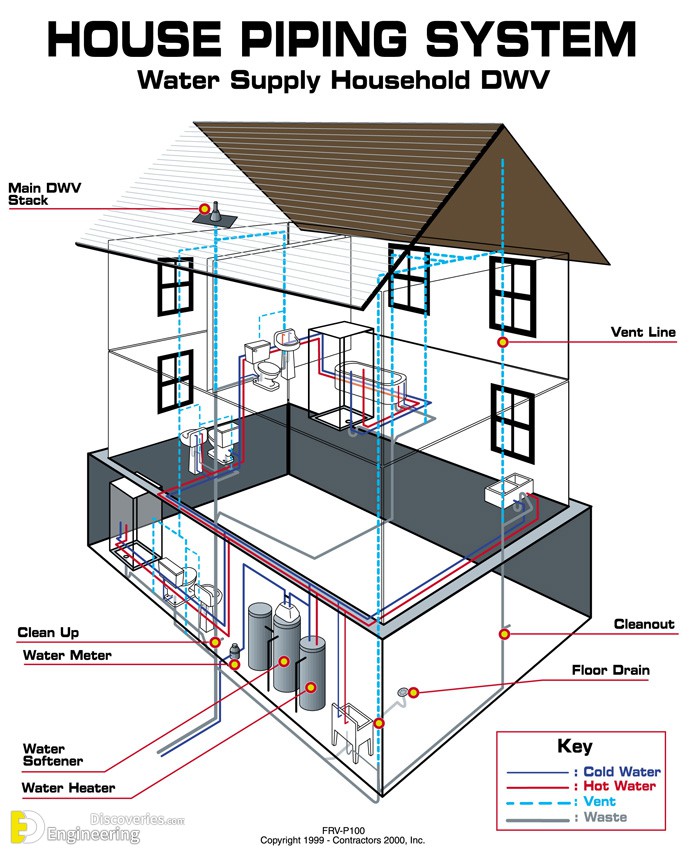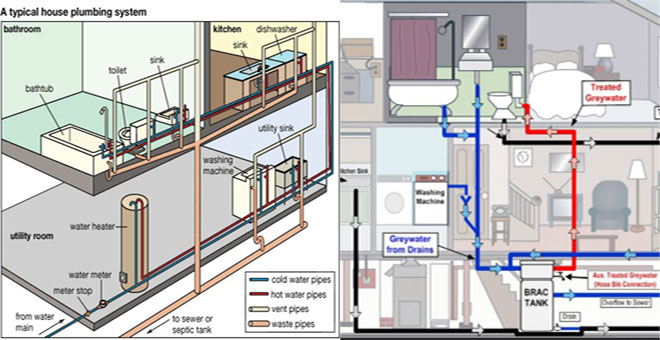The Complete Guide to Your Property's Plumbing System Anatomy
The Complete Guide to Your Property's Plumbing System Anatomy
Blog Article
The publisher is making a number of good annotation regarding Understanding Your Home's Plumbing Anatomy as a whole in this article on the next paragraphs.

Recognizing just how your home's plumbing system functions is crucial for each property owner. From supplying tidy water for drinking, food preparation, and showering to securely removing wastewater, a well-kept pipes system is critical for your household's health and comfort. In this comprehensive guide, we'll discover the intricate network that comprises your home's pipes and deal ideas on upkeep, upgrades, and taking care of typical concerns.
Intro
Your home's plumbing system is more than just a network of pipelines; it's a complicated system that guarantees you have access to tidy water and efficient wastewater elimination. Knowing its components and exactly how they interact can assist you stop pricey repairs and make sure whatever runs efficiently.
Standard Components of a Pipes System
Pipelines and Tubing
At the heart of your plumbing system are the pipelines and tubes that carry water throughout your home. These can be made from numerous products such as copper, PVC, or PEX, each with its advantages in terms of durability and cost-effectiveness.
Fixtures: Sinks, Toilets, Showers, etc.
Components like sinks, commodes, showers, and bathtubs are where water is utilized in your house. Recognizing just how these fixtures connect to the plumbing system assists in identifying troubles and planning upgrades.
Valves and Shut-off Points
Shutoffs regulate the circulation of water in your plumbing system. Shut-off valves are important during emergencies or when you require to make fixings, enabling you to isolate parts of the system without disrupting water flow to the whole residence.
Water System
Key Water Line
The primary water line connects your home to the metropolitan supply of water or a private well. It's where water enters your home and is distributed to various components.
Water Meter and Stress Regulatory Authority
The water meter steps your water usage, while a pressure regulatory authority makes certain that water streams at a risk-free pressure throughout your home's pipes system, protecting against damage to pipes and components.
Cold Water vs. Warm water Lines
Comprehending the distinction between cold water lines, which provide water directly from the main, and warm water lines, which bring heated water from the hot water heater, aids in fixing and planning for upgrades.
Drainage System
Drain Pipes Water Lines and Traps
Drain pipelines bring wastewater away from sinks, showers, and toilets to the sewage system or sewage-disposal tank. Traps protect against sewer gases from entering your home and additionally trap particles that might cause obstructions.
Air flow Pipes
Air flow pipelines allow air right into the drain system, avoiding suction that could reduce drain and cause catches to empty. Appropriate ventilation is vital for preserving the integrity of your plumbing system.
Value of Correct Water Drainage
Making certain correct water drainage protects against backups and water damage. Frequently cleaning up drains and maintaining traps can avoid costly repairs and extend the life of your plumbing system.
Water Heating Unit
Types of Hot Water Heater
Hot water heater can be tankless or typical tank-style. Tankless heating systems warmth water as needed, while storage tanks keep heated water for immediate usage.
Just How Water Heaters Link to the Plumbing System
Comprehending how water heaters attach to both the cold water supply and warm water distribution lines helps in diagnosing concerns like not enough warm water or leaks.
Maintenance Tips for Water Heaters
Consistently purging your water heater to remove sediment, checking the temperature level setups, and examining for leaks can expand its life expectancy and improve power effectiveness.
Typical Plumbing Concerns
Leaks and Their Causes
Leakages can happen due to maturing pipelines, loose installations, or high water stress. Dealing with leaks immediately avoids water damages and mold growth.
Blockages and Blockages
Obstructions in drains pipes and toilets are usually triggered by flushing non-flushable things or an accumulation of grease and hair. Making use of drain displays and being mindful of what goes down your drains pipes can prevent obstructions.
Indications of Pipes Issues to Watch For
Low tide pressure, sluggish drains, foul odors, or abnormally high water bills are indicators of potential pipes problems that need to be dealt with immediately.
Plumbing Upkeep Tips
Regular Assessments and Checks
Arrange annual plumbing assessments to catch problems early. Look for indications of leakages, rust, or mineral build-up in faucets and showerheads.
Do It Yourself Maintenance Tasks
Simple tasks like cleansing tap aerators, looking for commode leaks using dye tablet computers, or protecting subjected pipelines in cold environments can protect against major pipes issues.
When to Call an Expert Plumbing Professional
Know when a plumbing problem calls for professional competence. Trying complex repair services without correct knowledge can cause even more damage and higher repair service prices.
Upgrading Your Plumbing System
Factors for Upgrading
Updating to water-efficient components or replacing old pipes can enhance water top quality, reduce water bills, and boost the worth of your home.
Modern Pipes Technologies and Their Benefits
Explore technologies like clever leak detectors, water-saving toilets, and energy-efficient hot water heater that can conserve cash and reduce environmental effect.
Expense Factors To Consider and ROI
Compute the upfront costs versus long-lasting cost savings when thinking about plumbing upgrades. Numerous upgrades spend for themselves with minimized energy costs and less repairs.
Environmental Impact and Conservation
Water-Saving Fixtures and Home Appliances
Setting up low-flow taps, showerheads, and bathrooms can substantially lower water use without giving up efficiency.
Tips for Lowering Water Use
Straightforward behaviors like fixing leaks promptly, taking much shorter showers, and running complete lots of washing and recipes can preserve water and reduced your energy expenses.
Eco-Friendly Pipes Options
Think about sustainable plumbing materials like bamboo for flooring, which is durable and environmentally friendly, or recycled glass for countertops.
Emergency Readiness
Steps to Take During a Plumbing Emergency situation
Know where your shut-off shutoffs lie and exactly how to turn off the water supply in case of a ruptured pipe or major leakage.
Significance of Having Emergency Situation Get In Touches With Useful
Maintain call info for local plumbing professionals or emergency situation services readily available for fast feedback throughout a plumbing crisis.
Do It Yourself Emergency Fixes (When Relevant).
Short-term solutions like utilizing duct tape to spot a leaking pipe or placing a container under a dripping tap can minimize damages until a specialist plumbing gets here.
Final thought.
Recognizing the anatomy of your home's pipes system empowers you to preserve it effectively, conserving time and money on repair services. By following regular upkeep routines and staying notified about contemporary plumbing innovations, you can ensure your plumbing system runs efficiently for several years to come.
HOW YOUR PLUMBING SYSTEM WORKS
Which Pipes Do What?
Blue lines = fresh water supply entering the building
Red lines = hot water supply entering the building
Grey lines = pipes carrying waste away from the building and venting pipes carrying gases away from the building (through the roof)
YOUR MAIN PLUMBING SYSTEMS
There are two main plumbing systems that support your home s basic plumbing needs one that brings clean water into your home, and one that sends dirty water away from your home. Connected to the toilet, bath, shower, and other faucets in your home, these two systems keep your water flowing in the right directions.
ACCESSING FRESH WATER
Fresh and clean water is brought into your home through the main water supply line . Filtered through one pipe, this water is pressured to flow into the various fixtures in your home at any given time.
This water can be sourced from a well located on your property, a pond or river (mostly cottages), or, as in most cases, from the city s municipal water treatment centre. However, it is important to note that water that is untreated, such as the water siphoned from ponds or rivers, may not be safe to drink. Personal water supplies always need to be treated for hardness and contaminants before consumed.
MUNICIPAL WATER SUPPLIES
Improve taste and odour
Remove sediment
Eliminate hardness
Reduce chlorine
COLD WATER SUPPLY VS. HOT WATER SUPPLY
Cold water flows into your home or building through the service line, which then distributes hot or cold water to your fixtures. This line is most commonly run through a central column that runs floor to floor. Hot water runs in short and straight pipes as the longer the pipeline, the more heat that will be lost in the transfer. Having shorter pipes also allows residents to access hot water more quickly.
WASTE WATER SYSTEM
Your wastewater system is divided into two parts pipes that send wastewater away from your home and venting pipes that send sewer gas away from your home. Sewage water travels through pipes that flush the water and waste towards local sewers that are operated and managed by your city or town. Most sewer systems rely on gravity to move the wastewater to where it needs to go.
The further away from your toilet or sink, the larger wastewater pipes become. This allows for waste to be disposed of from various parts of your home or business at once without pipe blockages. The angle and flow of these pipes are also essential for keeping your waste pipes clear of build up.
https://harrisplumbing.ca/how-your-home-plumbing-system-works/

HOW YOUR PLUMBING SYSTEM WORKS
Which Pipes Do What?
YOUR MAIN PLUMBING SYSTEMS
There are two main plumbing systems that support your home s basic plumbing needs one that brings clean water into your home, and one that sends dirty water away from your home. Connected to the toilet, bath, shower, and other faucets in your home, these two systems keep your water flowing in the right directions.
ACCESSING FRESH WATER
Fresh and clean water is brought into your home through the main water supply line . Filtered through one pipe, this water is pressured to flow into the various fixtures in your home at any given time.
This water can be sourced from a well located on your property, a pond or river (mostly cottages), or, as in most cases, from the city s municipal water treatment centre. However, it is important to note that water that is untreated, such as the water siphoned from ponds or rivers, may not be safe to drink. Personal water supplies always need to be treated for hardness and contaminants before consumed.
MUNICIPAL WATER SUPPLIES
COLD WATER SUPPLY VS. HOT WATER SUPPLY
Cold water flows into your home or building through the service line, which then distributes hot or cold water to your fixtures. This line is most commonly run through a central column that runs floor to floor. Hot water runs in short and straight pipes as the longer the pipeline, the more heat that will be lost in the transfer. Having shorter pipes also allows residents to access hot water more quickly.
WASTE WATER SYSTEM
Your wastewater system is divided into two parts pipes that send wastewater away from your home and venting pipes that send sewer gas away from your home. Sewage water travels through pipes that flush the water and waste towards local sewers that are operated and managed by your city or town. Most sewer systems rely on gravity to move the wastewater to where it needs to go.
The further away from your toilet or sink, the larger wastewater pipes become. This allows for waste to be disposed of from various parts of your home or business at once without pipe blockages. The angle and flow of these pipes are also essential for keeping your waste pipes clear of build up.
https://harrisplumbing.ca/how-your-home-plumbing-system-works/
I came across that piece of writing on Understanding Your Home's Plumbing Anatomy while doing research the internet. Are you aware of someone else who is interested by the topic? Why not share it. Thank-you for taking the time to read it.
Quote & Schedule Report this page